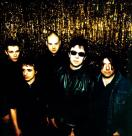 present day, all of whom drew from the equally diverse original sounds of '60s psychedelia. Whether they played trippy psychedelic pop (à la the Beatles, early Pink Floyd, and countless others), jangly Byrds-influenced guitar rock, distortion-drenched free-form jams, or mind-bending sonic experiments, these groups looked to psychedelia as a wellspring of evocative, unusual sounds, and either updated or unabashedly copied the original artists' approaches. Some neo-psychedelia was explicitly druggy, while for others it was simply a logical complement to their bizarre lyrics or left-of-center outlooks. Neo-psychedelia has occasionally hit the pop mainstream -- Prince's mid-'80s work, for example, and some of Lenny Kravitz's retro-worshipping output in the '90s. But for the most part, it has been chiefly the domain of alternative and indie-rock bands. Neo-psychedelia first appeared on the British post-punk scene at the end of the '70s, with major figures
present day, all of whom drew from the equally diverse original sounds of '60s psychedelia. Whether they played trippy psychedelic pop (à la the Beatles, early Pink Floyd, and countless others), jangly Byrds-influenced guitar rock, distortion-drenched free-form jams, or mind-bending sonic experiments, these groups looked to psychedelia as a wellspring of evocative, unusual sounds, and either updated or unabashedly copied the original artists' approaches. Some neo-psychedelia was explicitly druggy, while for others it was simply a logical complement to their bizarre lyrics or left-of-center outlooks. Neo-psychedelia has occasionally hit the pop mainstream -- Prince's mid-'80s work, for example, and some of Lenny Kravitz's retro-worshipping output in the '90s. But for the most part, it has been chiefly the domain of alternative and indie-rock bands. Neo-psychedelia first appeared on the British post-punk scene at the end of the '70s, with major figures including the Teardrop Explodes, Echo & the Bunnymen, and the Soft Boys. Aside from the early-'80s Paisley Underground movement and the Elephant 6 collective of the late '90s, most subsequent neo-psychedelia came from isolated eccentrics and revivalists, not cohesive scenes. Some of the biggest included the jangly, dreamy Australian band the Church; Nick Saloman's Bevis Frond, which mixed melodic songcraft with loud power-trio jamming; the droning, druggy haze of Spacemen 3; the quirky college rock of ex-Soft Boy Robyn Hitchcock; the utter weirdness of Mercury Rev and the Flaming Lips; and the eclectic Britpop of Wales' Super Furry Animals.
including the Teardrop Explodes, Echo & the Bunnymen, and the Soft Boys. Aside from the early-'80s Paisley Underground movement and the Elephant 6 collective of the late '90s, most subsequent neo-psychedelia came from isolated eccentrics and revivalists, not cohesive scenes. Some of the biggest included the jangly, dreamy Australian band the Church; Nick Saloman's Bevis Frond, which mixed melodic songcraft with loud power-trio jamming; the droning, druggy haze of Spacemen 3; the quirky college rock of ex-Soft Boy Robyn Hitchcock; the utter weirdness of Mercury Rev and the Flaming Lips; and the eclectic Britpop of Wales' Super Furry Animals.












0 COMMENTS:
Post a Comment